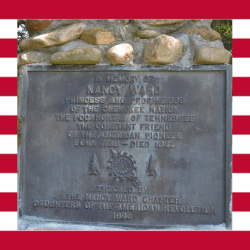
Growing up as an indigenous person in wartime America was incredibly tough. Not only did the people witness the battle for American independence, but they were simultaneously forced to advocate for their own visibility and for the land their families had been living on for generations not to be taken away from them. This tension spurred lots of conflict between European immigrants to the colonies and indigenous tribes, but that is not to say that all people within these groups looked at each other the same way.
Nanye’hi, a woman from the Cherokee Nation, advocated for peaceful coexistence with colonizers and European settlers; this viewpoint of hers was certainly contentious, as many other indigenous people understandably found it impossible to get along with the people who had stolen. Nanye’hi demonstrates that no community is a monolith, or can be assumed to have the same opinions, and her efforts to connect with European settlers ultimately resulted in positive outcomes for herself and her family.
She was born in 1773 in the town of Cherokee town of Chota. Growing up in the area, she was married at 17 to another member of the Cherokee group, and immediately began to see herself put in positions of authority within the community. Even at such a young age, she gave combat advice to other members of her nation and became the only woman member of the Cherokee General Council.
Following the death of her first husband, Nanye’hi remarried an Englishman named Bryan Ward, and was then given the anglicized name of Nancy Ward. Nanye’hi spent a few years with Bryan, whom she had one child with. He was in constant transport between the continental United States and England, where he had another family and another wife. The relationship between the two of them remained friendly their entire lives and demonstrated the possibility of members of different communities coexisting happily.
The connection between Nanye’hi and American society on a broader level, however, was much less positive. To her dismay, she noticed that women were relegated to the private sphere, and unable to participate in public life in the same way she would have been within Cherokee communities. This gender power imbalance highlights just once different indigenous people were forced to confront during European’s attempts to “integrate” them into the colonies.
Nanye’hi utilized the power she did have, however, to create speaking opportunities for her before Western councils, such as attending the 1785 Cherokee meeting with Revolutionary War leaders. This attendance helped strengthen the connection between Europeans and indigenous people, leading to decreased tensions between the two groups during the Revolutionary War.
She should be remembered as a woman who both challenged Wester norms but also worked to have Europeans integrated into continental America along with indigenous groups. Nanye’hi demonstrated that women from all walks of life had the ability to influence those around them and make changes for a more peaceful society.
